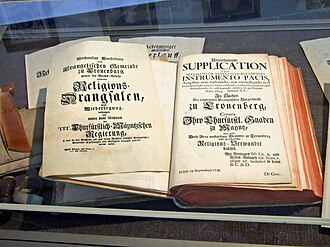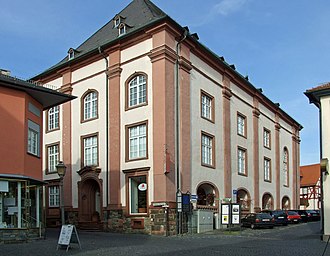Conflict church
The conflict church in Kronberg im Taunus is the structural relic of an attempted re-Catholicization of the city in the 18th century .
prehistory
Hartmut XII. von Kronberg , a cousin of Franz von Sickingen , had assisted him in his attack on Trier and Worms . In 1522 a coalition of Archbishop Richard von Greiffenklau zu Vollrads of Trier , Ludwig von der Pfalz and Landgrave Philipp the Magnanimous besieged the city and Kronberg Castle and forced their unconditional surrender. Hartmut XII. escaped. Landgrave Philipp occupied Kronberg in the following years and in 1526 it became Lutheran under him . In 1540 Philipp entered into a second morganatic marriage with the Saxon court maid Margarethe von der Saale , while his wife was still alive. With this bigamy , Philip encountered far-reaching political difficulties. Therefore he had to give the castle and town of Kronberg to Hartmut XII in 1541. hand back. But this happened on condition that the Lutheran Reformation be preserved. This was secured by an opening right for the Landgraviate of Hesse, which meant that the Landgraviate - also with military force - was allowed to intervene should the agreement be violated. This was confirmed by the Landgraviate of Hessen-Darmstadt in the 17th and 18th centuries after the Hessian inheritance was divided .
As early as the Thirty Years' War , Kurmainz occupied Kronberg in 1626 and carried out a Counter Reformation . In 1633 the French and Swedes drove the archbishop out and reintroduced the Reformation. In 1637 the imperial side had the upper hand again and a second Counter-Reformation was implemented. In the Peace of Westphalia , which was based on the normal year 1624, however, the Lutheran confession for Kronberg was re-established.
In 1704 the Lords of Kronberg died out and the Archbishop of Mainz received Kronberg as a fief . The new Roman Catholic ruler tried to carry out a third re-Catholicization of the territory.
Church building
The Roman Catholic services were held by Capuchin monks from Königstein in the castle chapel as "exercitium religionis privatum". The chapel soon proved to be too small after a proper Catholic priest and Catholic officials were transferred to Kronberg, contrary to the previous treaties, imperial statutes and peace agreements. For this reason and because of the demonstratively higher visibility, the state rulers supported the construction of a Roman Catholic church in the city of Kronberg itself in 1737. On the instructions of the Elector of Mainz (1732–1743) Philipp Karl von Eltz-Kempenich , a baroque church building was built according to plans from 1737 to 1739 Ignatius drill erected.
The protest of the evangelical townspeople was directed against this and against the influence on the chants to be kept in the evangelical church and the ringing of bells. The outrage of the Protestant subjects was sparked by two things: On the one hand, a building site directly next to the Protestant church was chosen (for which the new town hall, which had only been built 12 years earlier, was demolished and a public well filled in), and on the other hand, the government raised funds for the project Taxes and clamping services also from the evangelical subjects. Mainz quartered a commission led by a bailiff as well as soldiers in the city, whose behavior was also complained about.
The outraged Protestants, who saw their government's actions as a provocation, turned to their patron in religious matters, Landgrave Ernst Ludwig von Hessen-Darmstadt. This in turn switched on the Corpus Evangelicorum of the Perpetual Reichstag , which protested vigorously. While the Landgrave was still ready to compromise, the Corpus Evangelicorum was irreconcilable on the matter. So it came to a process before the Reich Chamber of Commerce , which ended in 1765 with the fact that the building of the "Streitkirche" by Elector Emmerich Joseph von Breidbach zu Bürresheim was prohibited and the conversion into a civil building was ordered by demolishing the gable tower.
Kurmainz had politically isolated himself in the Reich for years as a result of the incident . Even Catholic imperial estates did not support it on this issue.
Follow-up use and second church dispute
The building was never consecrated, the bell stalls were demolished and the building was used as a warehouse. The building now got its classical look. In 1820 the Roman Catholic parish sent a request to the government of the Duchy of Nassau (to which Kronberg had now belonged) to approve the expansion of the building and its use as a Roman Catholic church. The reason given was again the insufficient size of the castle chapel and its state of construction. The cost of the expansion was estimated at 7,000 guilders . The Roman Catholic pastor Schmidt submitted his own cost estimate, which amounted to 3379 guilders.
The government asked both parishes as well as the bailiff from Kronberg, Dr. Steel for opinion. The Roman Catholic community of course welcomed the building and added an expert opinion from the Nassau Medical Council Küster, in which they stated the dangers of the collapse of the chapel. Bailiff Dr. In his statement of December 30, 1820, Stahl confirmed the poor condition of the chapel and advocated the construction of a Roman Catholic church, which, however, should take place in coordination between the two denominations. On March 6, 1821, the Protestant church community categorically rejected the plan, referring to the prehistory. The Nassau government tried to find compromise solutions, but was unsuccessful. By decision of November 23, 1821, Duke Wilhelm I - against the advice of the ministry - finally refused to use the building as a church. It was not until 1876 that the Roman Catholic parish was able to build a new church elsewhere.
On June 19, 1823, an attempt was made to auction the building. Since not even half of the estimated price of 4,200 guilders was offered, the auction was repeated on August 13, 1823, and the building has served secular purposes ever since. The contract was awarded to the Kronberg citizen Philipp Glock for 1860 guilders, who had false ceilings installed and converted it into an inn (Nassauer Hof). At a renewed auction in 1887, the now finally secular conflict church went to the pharmacist Julius Neubronner for 12,600 marks , who used it as a house and shop. After a further renovation from 1977 to 1979, the Streitkirche was then sold for DM 3.8 million and has been privately owned since then. In the arcade there is a shop for exquisite women's fashions next to the farm pharmacy. The art dealer Galerie Uwe Opper with paintings from the 19th and 20th centuries is located on the first floor . The Kronberg Academy classrooms are on the 2nd floor. The Streitkirche is a cultural monument according to the Hessian Monument Protection Act .
Individual evidence
- ↑ IPO Art. V, Section 46.
literature
- A Hochlöbl. Corpus Evangelicorum zu Regenspurg Highly necessary presentation with the most submissive and obedient request Syndicorum der Evangelischen Burgerschektiven and Cronenberg parish 1739 online
- Actenmaessiger truthful course of some unruly Chur-Mayntzischen subjects in the small town of Cronenberg against their own rulership aroused unrest 1739 online
- Kurtze history narration, the religious essence in the city and Thal Cronenberg concerning 1740 online
- Heinz Duchhardt : Philipp Karl von Eltz . Elector of Mainz, Arch Chancellor of the Empire (1732–1743). Studies on the Electoral Mainz imperial and domestic policy. Society for Middle Rhine Church History, Mainz 1969 ( Sources and treatises on Middle Rhine Church history 10, ISSN 0480-7480 ), (At the same time: Mainz, Univ., Diss.).
- Wolfgang Ronner : The Kronberg church dispute - a confessional constitutional conflict in the 18th century. In: Yearbook of the Hessian Church History Association (JHKV) Volume 29, 1978, pp. 55–80
- Wolfgang Ronner : The Kronberg church dispute in the files of the Vienna Reichshof Chancellery. In: JHKV Volume 32, 1981, pp. 109-116
- Helmut Bode : Kronberg under Kurmainz. In: "Kronberg im Taunus, contributions to history, culture and art, published by the Association for History and Local History of the City of Kronberg eV" , Verlag Waldemar Kramer, Frankfurt am Main, 1980, ISBN 3-7829-0228-9 , p. 108 -121
- Gerhard Köbler : Historical lexicon of the German countries. The German territories from the Middle Ages to the present. 7th, completely revised edition. CH Beck, Munich 2007, ISBN 978-3-406-54986-1 .
- Hans Jürgen Schulz: The Kronberger Streitkirche, an expensive property of the Duchy of Nassau. In: Yearbook of the Hochtaunuskreis. 7, 1999, ZDB -ID 2580038-3 , pp. 74-82.
Web links
Coordinates: 50 ° 10 ′ 47.2 " N , 8 ° 30 ′ 30.7" E



